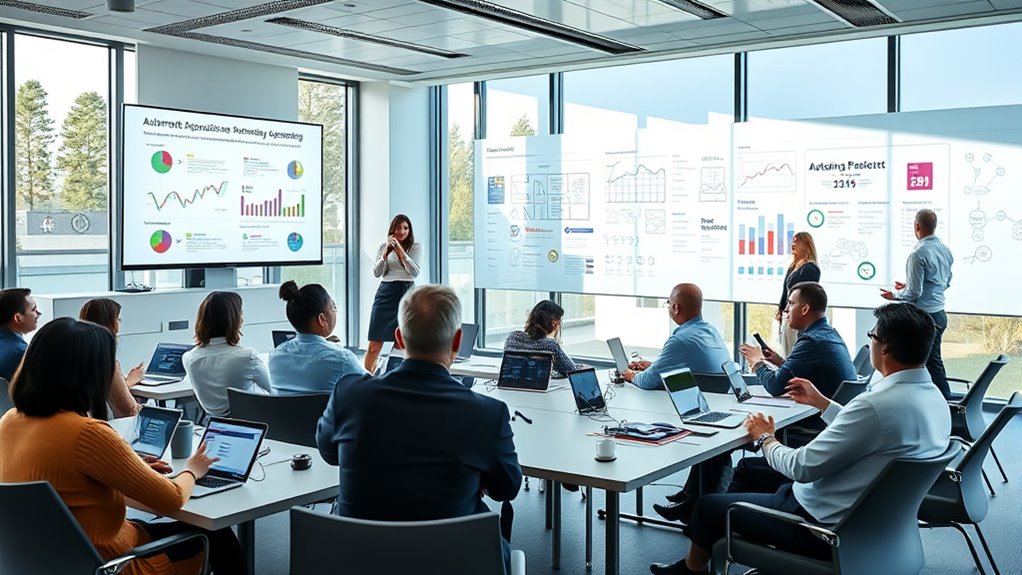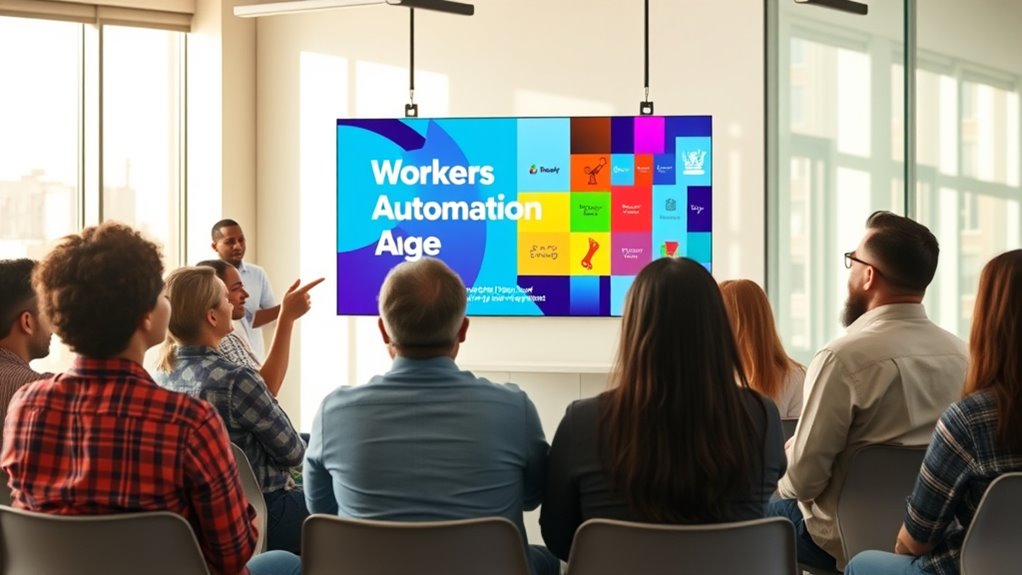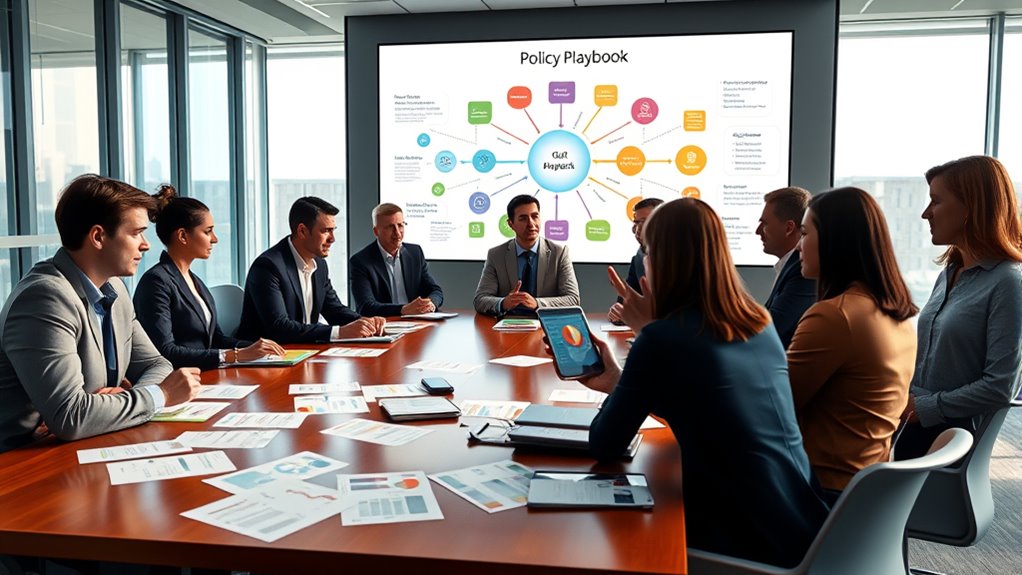To help workers in the automation age, you need a transition policy approach that addresses job impacts, promotes reskilling, and strengthens industry collaboration. Focus on developing flexible safety nets, investing in digital skills, and fostering innovation through partnerships. Encourage continuous learning and leverage technology to create new employment opportunities. With strategic actions, you can support workers’ transition smoothly—more solutions and insights are available if you keep exploring further.
Key Takeaways
- Develop policies supporting workforce transitions through targeted retraining, social safety nets, and regional labor market considerations.
- Promote continuous learning and digital skills development via industry partnerships and personalized AI-driven training programs.
- Foster industry collaboration, share best practices, and build organizational resilience to adapt to automation challenges.
- Incorporate ethical guidelines, data privacy, and security measures to ensure responsible implementation of automation technologies.
- Invest in education and lifelong learning initiatives to equip workers with skills relevant to emerging automation and data-driven roles.
Understanding the Impact of Automation on the Workforce

Automation is transforming the workforce at a rapid pace, with more than a third of all business tasks expected to be performed by machines by 2025. This shift means millions of jobs could be displaced, especially in industries like energy, utilities, and mining, where over 46.5% of roles are at high risk by 2030. In advanced economies, about 60% of jobs face automation threats, compared to 26% in low-income countries. As robots and autonomous systems grow, around 5 million jobs could disappear by 2030. Many workers, especially younger ones, worry about job security, with 30% fearing replacement by AI by 2025. Meanwhile, nearly all companies are investing in AI, but only 1% feel they’ve achieved full maturity. This rapid change demands understanding its broad economic and social impacts. The global economy could see a disruption exceeding $14.6 trillion in wages, highlighting the scale of potential upheaval. Additionally, understanding the benefits of new technologies can help mitigate some of these impacts and prepare the workforce for upcoming changes. Recognizing the role of technological innovation in economic growth can further aid in developing effective strategies to adapt to these transformations. Engaging in cost and budgeting strategies can also enable companies and workers to better navigate the financial challenges associated with automation. Furthermore, staying informed about sector performance metrics can assist investors and policymakers in making data-driven decisions to navigate this evolving landscape. Exploring home improvement strategies can also offer workers new avenues for skill development and alternative income sources outside of traditional employment.
Developing Effective Reskilling and Upskilling Strategies

As workplaces rapidly evolve due to technological advancements, investing in reskilling and upskilling becomes essential for maintaining a competitive edge. To develop effective strategies, you should focus on three key actions:
- Identify critical skills gaps through data analysis and industry insights. Incorporating insights from AI-powered data analysis can help target specific needs more accurately.
- Integrate personalized AI-driven training programs to enhance learning outcomes.
- Foster a culture of continuous learning by engaging employees in ongoing education and industry partnerships. Promoting lifelong learning and leveraging innovative tools can significantly improve adaptability.
- Understanding the importance of shelf life and storage conditions, such as storing in cool, dark places, can be applied to managing training resources and materials, ensuring they remain effective over time. Additionally, applying principles of Cultural Intelligence can help organizations better understand diverse learning preferences and adapt training methods accordingly, thereby increasing engagement and effectiveness. Recognizing the fundamentals of Basics of Soaring and Gliding, such as the importance of pre-flight checks and safety measures, can also inform the development of comprehensive safety protocols in training environments. These steps help ensure workers stay relevant in a digital economy. Encouraging mentorship and updating onboarding processes boosts workforce adaptability. By emphasizing digital literacy and leveraging innovative tools, you prepare your team for future challenges. This strategic approach not only supports individual growth but also strengthens your organization’s resilience and competitive advantage. Additionally, understanding that over 1 billion people worldwide could be affected by automation underscores the urgency of proactive reskilling initiatives as predicted by recent forecasts. Moreover, maintaining optimal storage conditions for training materials ensures the preservation of their quality and effectiveness over time.
Crafting Policy Frameworks to Support Transitioning Workers

Creating effective policy frameworks is essential to support workers as they shift to new jobs in a changing economy. Automation impacts employment, job quality, and skills requirements, often over generations. Your policies should focus on helping workers transition between roles, not blocking technological progress. Tailor strategies to regional labor markets, considering geographic differences in automation’s effects. Invest in education and training to equip workers with new skills in technology and data analysis. Strengthen social safety nets to cushion job losses and support economic stability. Make sure policies protect workers from negative impacts, like job displacement, while promoting job quality. Incorporate data privacy and security measures, and foster responsible automation through ethical guidelines and transparency. Additionally, understanding the specific essential oils for various health issues can inform holistic approaches to worker wellness and resilience. Supporting mental health and stress management is also crucial during periods of transition, emphasizing the importance of mental and emotional well-being techniques. Recognizing the importance of authenticity in policy-making can help build public trust and ensure that policies effectively address workers’ needs. Furthermore, implementing privacy policies ensures that data collection and usage are transparent and respectful of individual rights. Incorporating AI-driven tools into workforce policies can enhance decision-making and help identify areas for targeted support. Ultimately, your frameworks must balance technological advancement with societal well-being and sustainable workforce transitions.
Promoting Industry Collaboration for Workforce Resilience

Industry collaboration plays a pivotal role in building workforce resilience amid ongoing technological change. By working together, you can foster shared knowledge, promote innovation, and streamline processes. To maximize these benefits:
Collaborating industry-wide boosts resilience through shared knowledge, innovation, and streamlined processes in times of change.
- Implement digital collaboration tools and in-person workshops to improve communication and efficiency.
- Share best practices and resources through industry-wide databases and partnerships.
- Develop industry-specific training programs, like resilience initiatives, to prepare workers for automation challenges.
- Research shows that 73% of employees engaging in collaborative work report improved performance, highlighting the importance of collective efforts. Despite these benefits, only 16% of employers currently invest in resilience training, which highlights the need for increased commitment. Effective wall organization can facilitate better collaboration spaces and improve overall workspace efficiency. Building a culture of continuous learning can further enhance adaptability and innovation within organizations. Balancing competition with collaboration can be tricky, but strategic partnerships can help organizations adapt faster. Emphasizing industry-wide efforts will strengthen workforce resilience and guarantee smoother transitions in the automation age. Encouraging a culture of open communication is essential for sustaining these collaborative initiatives and ensuring continuous improvement. Additionally, leveraging remote hackathons can facilitate cross-industry innovation and skill-sharing to further bolster workforce capabilities. Moreover, understanding and applying insights from Personality Traits can enhance team dynamics and leadership effectiveness in these collaborative settings.
Leveraging Technology to Enhance Employment Opportunities

Technological advancements are opening new pathways to employment by transforming how jobs are created and filled. Nearly 92% of today’s jobs require digital skills, making tech training essential. New roles in IT, app development, hardware manufacturing, and systems management have emerged in the past 25 years, creating opportunities that didn’t exist before. The Internet has generated a net increase in jobs; for example, in France, it replaced 500,000 jobs but created 1.2 million over 15 years. The rise of big data is fueling demand for data analysts, with an estimated shortfall of 250,000 data scientists in the U.S. by 2035. Additionally, technology fosters entrepreneurial ventures, especially for small businesses and self-employed workers, offering higher income prospects. Digital literacy is becoming increasingly crucial across all industries, ensuring workers can adapt to ongoing technological changes. Moreover, collaborative tools are facilitating remote work and expanding employment opportunities globally. As a result, understanding GMC tuning can also empower workers in related technical fields to optimize vehicle performance and maintenance, opening new career avenues. Furthermore, staying updated on emerging automation trends is vital for adapting skills and remaining competitive in a rapidly evolving job market.
Ensuring Fair and Adaptive Safety Nets for Displaced Employees

How can we guarantee that safety nets keep pace with rapid automation and effectively support displaced workers? To do this, you need to focus on three key actions:
- Expand and adapt existing social programs to cover income support and retraining needs during changeover periods. Incorporating modern workforce development strategies can improve resilience and adaptability.
- Develop targeted policies that prioritize high-risk sectors, ensuring workers receive timely assistance.
- Foster coordination among government, industry, and educational institutions to create flexible safety nets tailored to regional and sector-specific automation impacts. Implementing a Financial Aspects framework can enhance the effectiveness of these safety measures.
Frequently Asked Questions
How Can Small Businesses Effectively Adapt to Automation-Driven Changes?
You can effectively adapt to automation-driven changes by embracing new technologies that streamline your workflows and cut costs. Automate routine tasks like social media posting and email campaigns to save time and boost engagement. Leverage AI tools and low-code platforms to improve decision-making and operational efficiency. Focus on integrating automation smoothly into your existing processes, allowing your team to concentrate on growth and innovation rather than repetitive work.
What Role Do Educational Institutions Play in Workforce Transition Strategies?
Educational institutions play a pivotal role in workforce shift strategies by offering lifelong learning and retraining programs that help you adapt to automation. They partner with employers to provide tailored training, develop curricula focused on digital and social skills, and expand apprenticeships. These efforts guarantee you gain future-ready competencies, making it easier for you to transition into new roles, stay employable, and thrive in an evolving job market.
How Can Policymakers Address Ethical Concerns Related to Automation and AI?
You can address ethical concerns related to automation and AI by creating clear regulations that promote transparency and accountability. Guarantee AI systems are designed to reduce bias and protect privacy, while establishing standards for responsible use. Engage diverse stakeholders in policymaking to reflect societal values, and enforce strict data protection laws. By doing so, you foster trust, mitigate risks, and promote ethical development and deployment of AI technologies.
What Are the Best Practices for Measuring Automation’S Impact on Employment Quality?
When measuring automation’s impact on employment quality, you should track wage changes, employment ratios, and job displacement rates. Focus on how job content, safety, and work-life balance evolve, and analyze data from surveys, occupational risk assessments, and firm profits. Consider sector differences and time lags, distinguishing between jobs replaced and those augmented. Incorporate both quantitative and qualitative insights to get a thorough understanding of automation’s effects.
How Can International Cooperation Enhance Global Automation Workforce Policies?
Did you know that countries with strong international cooperation see up to 30% faster progress in adapting workforce policies? You can enhance global automation workforce policies by engaging in international forums, sharing best practices, and aligning standards through organizations like the ILO. Collaborating across borders helps you develop inclusive, ethical policies that protect workers, promote lifelong learning, and ensure automation benefits everyone, regardless of where they work.
Conclusion
As you navigate the shifting landscape of automation, think of the workforce as a ship steering through unpredictable waters. Your proactive policies and collaboration act as the sturdy helm, guiding workers safely to new opportunities. By embracing reskilling, fostering innovation, and ensuring fair safety nets, you can turn this storm into a voyage of growth. Together, you’ll chart a course toward resilience, ensuring no one is left adrift in the age of automation.









